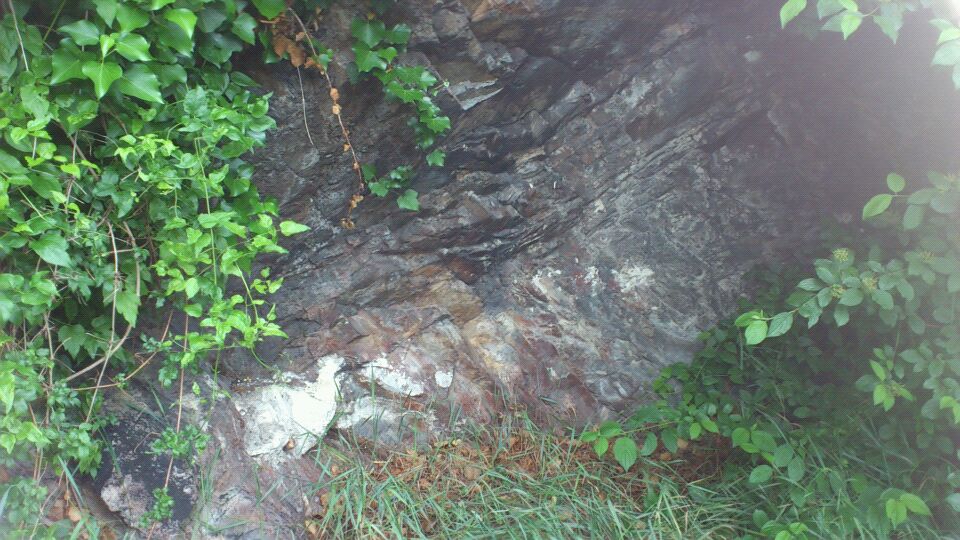Ein schöner Ort für einen Earthcache!


Eine geologische Spezialität des Semmeringgebietes stellt der sogenannte Forellenstein (Orthoriebeckitgneis) beim Schloß Gloggnitz dar.
Gloggnitz zählt durch die Lage am Fuße des romantischen Semmerings zu den beliebten Ausflugsgebieten. Als Semmeringfenster oder Semmeringsystem bezeichnet die Geologie das Gebiet um den Semmering - Pass zwischen der Steiermark und Niederösterreich.
Metamorphe Gesteine wie Schiefer, Quarzite, Phylite aber auch Grüngesteine und sonstige metamorphe Ergußgesteine sind in der Grauwackenzone eingelagert.Die Enstehung erfolgt durch Umwandlung und Aufpressung (Metamorphose) eines sauren Eruptivgesteins (Rhyolith) in Folge der Alpenhebung am Ende des Mesozoikums. Eruptivgesteine sind oft sehr feinkörnig oder sogar glasig erstarrt, was zu einer gleichmäßigeren Färbung führt. Das Mesozoikum auch Erdmittelalter genannt, ist ein Erdzeitalter, das vor etwa 251 Millionen Jahren begann und vor etwa 65,5 Millionen Jahren endete.Metamorphose (Umwandlung) kommt nicht nur in der Geologie vor sonder auch in der Botanik und in der Zoologie. Als Beispiel in der Zoologie wäre die Umwandlung einer Raupe über die Puppe zum Schmetterling.
Eines der schönsten Umwandlungsgesteine der Grauwackenzone ist bei uns der Forellenstein (Ortho-Riebeckit-Gneis) bei Gloggnitz.Der "Forellenstein" von Gloggnitz ist als Lager mit altpaläozoischen Schiefer eingeschichtet.Die dunklen und roten Flecken des Gesteins sind Hämatit und Riebeckit, die Hauptgemengeteile Kalifeldspat, Quarz und Albit.Das schönste Riebeckitgneisvorkommen ist das am Brandlberg nördlich Raxen.
Einige der Antworten findest Du an der Infotafel!
Um den Cache als "Gefunden" loggen zu dürfen, müßt ihr folgende Fragen beantworten:
Frage 1. Wie nennt man die Entstehung des Gesteins?( Wort in Klammern 12 Buchstaben).
Frage 2. Wie ist der Name der letzten Merkmals des Gesteins?( Wort in rot mit 7 Buchstaben)?
Frage 3. Vom Parkplatz kommend findet Ihr den Felsen vom Bild. Wieviel Farben könnt Ihr erkennen und wie Stark (in cm) sind die jeweiligen Schichten?
Ihr könnt sofort loggen, ich melde mich, wenn etwas nicht stimmt
Die Antworten bitte per e-mail an mich
Schreibt in die Betreffzeile der Mail bitte Euren GC-Namen.
Foto1: Macht bitte von euch oder euerm GPS-Gerät ein Bild an N 47° 40.400 E 015° 55.838
Auch auf Opencaching gelistet.

A geological specialty of the Semmering area is the so-called rock trout (Orthoriebeckitgneis) at the castle Gloggnitz dar.
Gloggnitz counted by the location at the foot of the Semmering popular romantic trip to the area. As Semmering Semmering window or the geology of the area designated system to the Semmering - mountain pass between Styria and Lower Austria.
Metamorphic rocks such as schist, quartzite, but also Phylite green metamorphic rocks and other effusive rocks are made in the greywacke zone eingelagert.Die Enste by Hung and Aufpressung transformation (metamorphosis) of an acidic Eruptivgesteins (rhyolite) as a result of Alpine uplift at the end of the Mesozoic. Igneous rocks are often very fine-grained or even glassy solidified, leading to a more uniform staining. The Mesozoic Mesozoic is known as an era that began about 251 million years ago and about 65.5 million years endete.Metamorphose (conversion) is not only before but also in geology in botany and in zoology. As an example in zoology would be the transformation of a caterpillar through the pupa to butterfly.
One of the most beautiful conversion rocks of the greywacke zone is for us the trout stone (Ortho-riebeckite-gneiss) at Gloggnitz.Der "Trout stone" of Gloggnitz is eingeschichtet.Die as a warehouse with Paleozoic shale and dark red spots on the rocks are hematite and riebeckite, the main batch parts feldspar , quartz and Albit.Das is the most beautiful Riebeckitgneisvorkommen Raxen Brandlberg the north.
Some answers can be found on the notice board.
To log the cache as "found" may have to answer the following questions:
Question 1 What do you call the origin of the rock? (12 letters word in brackets).
Question 2 What is the name of the last characteristic of the rock? (Word in red with 7 letters)?
Question 3 Coming from the parking area you will find the rocks from the image. How many colors can you see and how heavy (in cm) are the respective layers?
You can log in immediately, I'll be in touch when something is wrong
The answers via e-mail me
Write in the subject line of your email please GC name.
Photo1: power of you or your GPS device euerm an image of N 47 ° 40 400 55 838 E 015 °